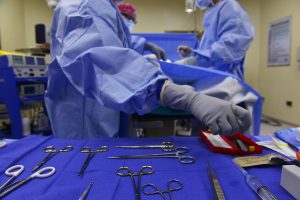
Year: 2019 and 2026
Market size: $10.48 billion and $20.50 billion, respectively
Antimicrobial textiles are fabrics coated with substances that destroy or inhibit the growth of microorganisms such as bacteria, viruses, protozoans, mold, and mildew. These substances can also be incorporated within the fibers of the fabric. Today’s market size shows the global revenues for antimicrobial textiles in 2019 and projected for 2026. These specialty textiles accounted for about 1% of total worldwide textile revenues in 2019.
The use of antimicrobial substances is nothing new. The ancient Egyptians used spices and herbs to preserve mummy wraps. The Chinese used bamboo, which contains the antimicrobial substance bamboo-kun, in housing structures and decor. And, during World War II the militaries on both sides of the conflict used antimicrobials to protect military gear from rotting. The antimicrobials used during World War II, however, were found to cause serious health problems and polluted the earth. In the 1960s, after Rachel Carson’s book Silent Spring was published, public and private organizations hired ecologists, scientists, and industrial chemists to develop more eco-friendly antimicrobials. Some antimicrobials such as silver nanoparticles and triclosan can wash off fabrics when laundered and pollute local water sources. Several newer antimicrobial coatings currently in use and in development do not do this thereby minimizing the harmful effects to the environment and prolonging the antimicrobial properties of the fabric.Nearly half of the antimicrobial textiles used are made of polyester. The fiber is readily available and can be combined with other fibers such as cotton, vinyl, and others to create a wide range of fabrics for use in many different applications. Antimicrobial textiles are used in healthcare; hygiene; medical devices; sportswear; food packaging; storage; thermal and mechanical protection; automotive textiles; heating, ventilation and air conditioning; air filters; and water purification systems.
More than 45% of consumption occurs in the healthcare sector. Surgeon’s gowns, bed sheets, curtains, and masks are some of the items made with these textiles. Increasing requirements to reduce hospital-acquired infections, growing demand for advanced safety products, and increasing need for personal protective equipment due to the COVID-19 pandemic are all expected to contribute to the growing demand for antimicrobial textiles in the coming years. In May 2020, the first antiviral chemical coating for textiles that kills the SARS-CoV-2 virus, PROTX2-AV, was proven effective in lab tests and is awaiting Environmental Protection Agency approval in the United States to market it. The company that developed it, Intelligent Fabric Technologies North America, is producing its own line of personal protective equipment and other clothing using fabrics coated with it. The company is also working with manufacturing partners to produce healthcare and athletic apparel, military uniforms, medical dressings, and car and aircraft seats treated with PROTX2-AV. Other producers of antimicrobial textiles include Kolon Industries, Milliken & Company, Toyobo Co. Ltd., Unitika Ltd., Trevira GmbH, and Thai Acrylic Fibre Co. Ltd.
Sources: Kiran Pulidindi and Hemant Pandey, “Antimicrobial Textiles Market Size by Fabric (Polyester, Polyamide, Cotton), by Application (Healthcare, Apparels, Home Textile), by Active Agents (Metal & Metallic Salts, Synthetic Organic Compounds, Biobased Agents), Industry Analysis Report, Regional Outlook, Growth Potential, Price Trends, Competitive Market Share & Forecast, 2020 – 2026,” Global Market Insights Summary, April 2020 available online here; “Antimicrobial Textiles Market is Likely to Surpass $20.5 Billion by 2026, Says Global Market Insights Inc.,” CISION PR Newswire Press Release, April 19, 2020 available online here; Leslie Haddad, “A Beginner’s Guide: What is Antimicrobial Fabric?” February 16, 2017 available online here; “Textile Market Size, Share & Trends Analysis Report by Raw Material (Wool, Chemical, Silk, Cotton), by Product (Natural Fibers, Polyester, Nylon), by Application, by Region, and Segment Forecasts, 2020 – 2027,” Grand View Research Report Summary, February 2020 available online here; Susan Karlin, “With This Antiviral Fabric Coating, Your Clothing Could Protect You From COVID-19,” Fast Company, May 26, 2020 available online here.Image source: skeeze, “surgery-instruments-surgeons-688380,” Pixabay, March 25, 2015 available online here.
